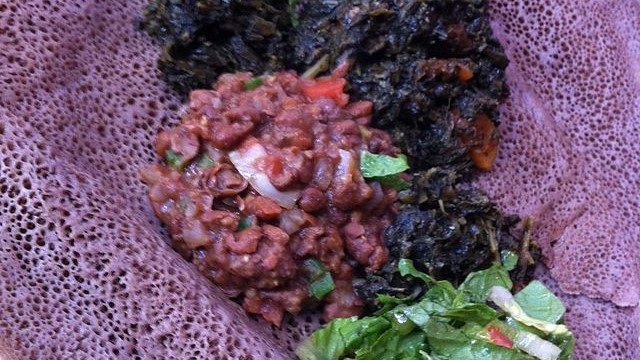In Eritrea, food is rarely just sustenance. It is a marker of heritage, a reflection of history, and a deeply communal ritual. At the center of this tradition lies injera, the spongy sourdough flatbread that defines much of the country’s cuisine and acts as both utensil and table. Around it gather richly seasoned stews—meat, lentil, or vegetable—that transform a meal into something closer to a shared ceremony.
Prepared from finely milled teff, a tiny gluten-free grain native to the Horn of Africa, injera requires patience and skill. The batter ferments for several days before being ladled onto a hot griddle, spreading into wide, soft circles pocked with tiny air holes. Its faint tang, reminiscent of sourdough, and pliant, absorbent texture make it the foundation of Eritrean dining. Every stew, every flavor finds its place upon its surface.
The accompaniments, known collectively as wat, vary in character and intensity. Doro wat, a slow-cooked chicken stew laced with berbere—a layered blend of chili, garlic, ginger, fenugreek, and other spices—remains among the most celebrated. The dish is dense with heat and depth, its richness offset by the gentle sourness of injera. Vegetarian traditions contribute their own signatures: misir wat, made with lentils simmered in berbere and onions, brings equal intensity without meat, while shiro, a chickpea flour stew, delivers a smooth, earthy counterpoint.
Meals are typically presented on a broad, shared platter. A large round of injera forms the base, while the stews are spooned directly onto its surface. Diners tear pieces of the bread by hand, using it to scoop, mix, and taste. The practice emphasizes not only flavor but fellowship. Eating in this way is an affirmation of collective identity, where food functions as conversation as much as nourishment.
Beverages deepen the cultural dimension of the meal. Coffee, prepared through the elaborate jebena ceremony, often follows, its thick, aromatic brew balancing the spice-laden dishes. On other occasions, glasses of tej—a sweet honey wine—provide a gentler counterpoint, cooling the heat and extending the gathering into hours.
To partake in injera and its stews is to encounter Eritrea’s long story of endurance and community, written into recipes passed across generations. Every bite carries the cadence of the country’s landscape and traditions, reminding those at the table that food here is not simply eaten but shared, celebrated, and remembered.
Sources:
- Helen Sabra, Injera: The Ethiopian and Eritrean Flatbread Tradition, African Culinary Studies Journal, 2019.
- Jessica B. Harris, High on the Hog: A Culinary Journey from Africa to America, Bloomsbury, 2011.
- UNESCO Intangible Cultural Heritage, “Foodways of the Horn of Africa,” accessed 2023.
- Fran Osseo-Asare, Food Culture in Sub-Saharan Africa, Greenwood Press, 2005.


